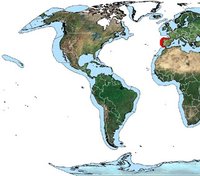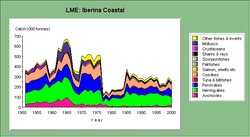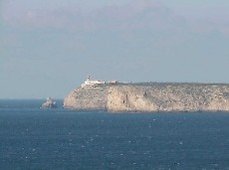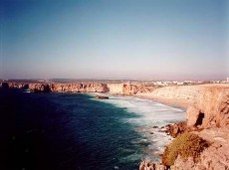Iberian Coastal large marine ecosystem
 Location of the Iberian Coastal Large Marine Ecosystem. (Source: NOAA)
Location of the Iberian Coastal Large Marine Ecosystem. (Source: NOAA) The Iberian Coastal large marine ecosystem (LME) is a continental shelf region of the eastern Atlantic Ocean lying between about 36° N (Gulf of Cadiz) and 44° N (Cantabrian Sea). It is a western boundary ecosystem characterized by a temperate climate. Topographical features and circulation patterns play an important role. This seaboard of Western Europe is very diversified. It is a fractal area, with a coastline is indented with rias, or drowned river valleys. Climate and upwelling are the primary force driving the LME, with intensive fishing as the secondary driving force. The two countries bordering the LME are Spain and Portugal. LME book chapters and articles pertaining to this LME include Wyatt and Perez-Gandaras, 1989, and Wyatt and Porteiro, 2002.
Contents
- 1 Productivity
- 2 Fish and Fisheries
- 3 Pollution and Ecosystem Health
- 4 Socioeconomic Conditions
- 5 Governance
- 6 Articles and LME Volumes FAO, 2003. Trends in oceanic captures and clustering of large marine ecosystems—2 studies based on the FAO capture database. FAO fisheries technical paper (Iberian Coastal large marine ecosystem) 435. 71 pages. * Prescott, J.R.V. The political division of large marine ecosystems in the Atlantic Ocean and some associated seas. In K. Sherman and L.M. Alexander, eds. Biomass Yields and Geography of Large Marine Ecosystems. AAAS Selected Symposium 111. Westview Press, Boulder CO. 395–442, 1989. ISBN: 0813378443. * Wyatt, Tim and G. Perez-Gandaras. 1989. Biomass Changes in the Iberian Ecosystem. In Kenneth Sherman and Lewis M. Alexander (eds.), Biomass Yields and Geography of Large Marine Ecosystems (Boulder: Westview, 1989). AAAS Selected Symposium 111. 221-239. ISBN: 0813378443. * Wyatt, T. and C. Porteiro, 2002. Iberian Sardine Fisheries: trends and crises. In K. Sherman and H.R. Skjoldal, eds. Large Marine Ecosystems of the North Atlantic—Changing states and Sustainability. Elseviers. 321-338.
- 7 Other References
Productivity
 LME: Iberian Coastal. (Source: NOAA)
LME: Iberian Coastal. (Source: NOAA) The continental shelf varies in width from 15 to nearly 400 kilometres (km). Productivity and resource abundance are driven by climate and upwelling. The importance of climate is suggested by the link between sardine catches and Ekman drift, and by the link between anchovy catches in this LME and biological changes in the western English Channel (see Wyatt and Perez-Gandaras, 1989). Upwelling takes place in the northern spring and summer along the coasts of Portugal and Western Galicia. For more on changes in oceanographic conditions in this LME, see Wyatt and Porteiro, 2002. The Iberian Coastal LME is considered a Class II, moderately productive (150-300 grams of Carbon per square metre per year) ecosystem based on SeaWiFS global primary productivity estimates. Margalef (1956) identified marked changes in the phytoplankton composition of Galician waters during the 1950s sardine crisis there. The LME is characterized by favorable conditions for the production of clupeoids and other small pelagic fishes. For biomass changes in sardine, see Wyatt and Perez-Gandaras, 1989. Changes in the upwelling regime affected the sardine stock. There were changes in the phytoplankton composition and in the patterns of water exchange between the rias and the open sea. Major changes in sardine abundance were accompanied by equally radical changes in other trophic levels. Good sardine productivity is linked with the presence of the diatom Melosira (Paralia) sulcata, and poor productivity with Thalassiosira rotula “invasions”. There are marked changes in the abundance of certain dinoflagellate species. See the ocean triads model for an explanation of upwelling, concentration of larval food brought about by convergences, and mesoscale circulation patterns that help to maintain larval retention (Wyatt and Porteiro, 2002).
Fish and Fisheries
 (Source: NOAA)
(Source: NOAA) Trends in catches by species groupings have been quite stable in recent years. The Food and Agriculture Organization (FAO) 10-year trend shows an average catch of 350,000 tons (see FAO, 2003). Landings have decreased since the 1980s. For landings of fish in 1981, and for examples of biomass changes in sardine, sprat, and anchovy, see Wyatt and Perez-Gandaras, 1989. Catch composition is dominated by three groups: herrings, sardines and anchovies (42%), pelagic fishes (28%), and cods, hakes and haddocks. For a description of fisheries geography and Iberian sardine fisheries in crisis in the 1940s and 1950s, see Wyatt and Porteiro, 2002. Coastal species harvested are anchovy, sardine, mackerel and horse-mackerel. Hake, blue whiting, bream, bogue, pilchards, sprat, and tuna are also harvested. Fisheries technology has introduced nylon nets and sonar equipment. For biomass changes in sardine, sprat, anchovy and other species, see Wyatt and Perez-Gandaras, 1989. The University of British Columbia Fisheries Center has detailed fish catch statistics for this LME.
Pollution and Ecosystem Health
Red tides were a more or less annual occurrence in the Rias Bajas from the beginning of the 20th century until the 1950s. These were almost always due to the dinoflagellate Gonyaulax, and sometimes to the ciliate Mesodinium. Since the 1970s, Gonyaulax blooms have not been reported in the Rias Bajas. Instead, there have been occasional blooms of the toxic dinoflagellates Alexandrium tamarense, A. minutum and Gymnodinium catenatum. These phytoplankton changes are seen as part of a worldwide increase in the frequency and intensity of harmful algal blooms, and are attributed to various causes including eutrophication and ballast water transport. According to Wyatt and Porteiro (2002), on the whole, pollution (Water pollution) is not of major importance in the Iberian LME, except in a few localized [[region]s].
Socioeconomic Conditions
 (Source: NOAA)
(Source: NOAA) Spain and Portugal are important fishing nations in the European Union. Spain has the largest distant water fleet of any European country. The center of gravity of the Spanish anchovy fishery has moved eastwards, resulting in almost the entire catch being landed in Basque ports. Technical changes in the Basque fishery accounted for part of the increase in landings after the 1960s (see Igelmo et al., 1984). Spain is gradually being excluded from several of its traditional extraterritorial fishing grounds, and will need to focus on the management of its more local resources. A blue mussel farming industry, initiated in the 1950s in the Rias Bajas, produces about 200,000 tons annually. In the main area of raft cultivation, the Ria de Arosa, the standing stock of mussels is near or above carrying capacity. Mussels alone could consume the entire annual production of phytoplankton.
Governance
The LME is bordered by Spain and Portugal. The entire LME, being relatively small, can be surveyed with the resources already available in the two countries. Both countries belong to the European Union, and both collaborate effectively in various fisheries contexts. The exploitation of the natural marine resources of the Iberian Coastal Large Marine Ecosystem follows a number of conventions, declarations and regulations, including the European Commission directives and regulations within the Common Fisheries Policies. All in all a large number of instruments from international bodies, such as the United Nations, the International Maritime Organization, and the European Union, exist to conserve natural resources, protect the environment and ensure health and safety standards. The European Community laws protect the environment in terms of air (Air pollution) and noise, chemicals and industrial risks, nature conservation, waste and water.
Articles and LME Volumes FAO, 2003. Trends in oceanic captures and clustering of large marine ecosystems—2 studies based on the FAO capture database. FAO fisheries technical paper (Iberian Coastal large marine ecosystem) 435. 71 pages. * Prescott, J.R.V. The political division of large marine ecosystems in the Atlantic Ocean and some associated seas. In K. Sherman and L.M. Alexander, eds. Biomass Yields and Geography of Large Marine Ecosystems. AAAS Selected Symposium 111. Westview Press, Boulder CO. 395–442, 1989. ISBN: 0813378443. * Wyatt, Tim and G. Perez-Gandaras. 1989. Biomass Changes in the Iberian Ecosystem. In Kenneth Sherman and Lewis M. Alexander (eds.), Biomass Yields and Geography of Large Marine Ecosystems (Boulder: Westview, 1989). AAAS Selected Symposium 111. 221-239. ISBN: 0813378443. * Wyatt, T. and C. Porteiro, 2002. Iberian Sardine Fisheries: trends and crises. In K. Sherman and H.R. Skjoldal, eds. Large Marine Ecosystems of the North Atlantic—Changing states and Sustainability. Elseviers. 321-338.
Other References
- Igelmo, A.X., Iribar, X., and Lerga, S. 1984. Inventario de artes de pesca en Euskadi. Publ. Gobierno Vasco. Dep. Com., Pesca Y Turismo. 305 p. ISBN: 8475420818.
- Lluch-Belda, D., R.J.M. Crawford, T. Kawasaki, A.D. MacCall, R.H. Parrish, R.A. Schwartzlose, and P.E. Smith, 1989. World-wide fluctuations of sardine and anchovy stocks: the regime problem. South African Journal of marine Science 8:195-205.
- Margalef, R., 1956. Paleoecologia postglaciar de la ria de Vigo. Investigaciones Pesqueras 5:89-112.
- Wooster, W.S., Bakun, A., and McLain, D.R. 1976. The seasonal upwelling cycle along the eastern boundary of the North Atlantique. J. Mar. Res. 34:131-141.
- Wyatt, T., D.H. Cushing, and S. Junquera, 1991. Stock distinctions and evolution of the European sardine. In: T. Kawasaki, S. Tanaka, Y. Toba, and A. Taniguchi (eds). Long-term variability of pelagic fish populations and their environment. Pergamon. 229-238.
| Disclaimer: This article contains some information that was originally published by the National Oceanic and Atmospheric Administration (NOAA). Topic editors and authors for the Encyclopedia of Earth have edited its content and added new information. The use of information from the National Oceanic and Atmospheric Administration (NOAA) should not be construed as support for or endorsement by that organization for any new information added by EoE personnel, or for any editing of the original content. |